

In 2003, Activision selected several homebrew 2600 games for inclusion in the Game Boy Advance version of its Activision Anthology: Climber 5 by Dennis Debro (2004), Okie Dokie by Bob Colbert (1996), Skeleton+ by Eric Ball (2003), Space Treat Deluxe by Fabrizio Zavagli (2003), Vault Assault by Brian Prescott (2001), Video Euchre by Erik Eid (2002), and Oystron. See also: List of Atari 2600 homebrew games One hack target is the 2600 version of Pac-Man, in which the graphic elements are reworked to more closely resemble the arcade version. Modifications typically include new graphics and game colors, but may also include gameplay modifications and the ability to use a different controller than the one for which the game was originally designed. ROM hacking modifies existing ROM images. Other 2600 demakes include the Portal-inspired Super 3D Portals 6 and a demo based on the Mega Man franchise. It was written by former Microsoft vice-president Ed Fries, who was involved in Microsoft's acquisition of Halo creator Bungie.
#Euchre 3d data usage series
Halo 2600 is a 4 KB game inspired by the Halo series of games. Ī demake is a port from a system generations past the 2600. Duck Attack! allows the player to battle giant, fire-breathing ducks in a quest to save the world from a mad scientist. Oystron, released by Piero Cavina in 1997, is an action game in which "space oysters" are opened and pearls collected to earn ammunition. In SCSIcide, released by Joe Grand in 2001, the player acts as a hard drive read head picking up color-coded data bits as they fly past. While the majority of the hobbyist development community uses designs from existing games, there are also original titles. Medieval Mayhem by, Darrell Spice Jr., is a version of the 1980 arcade game Warlords which includes elements omitted from Atari's official port. Warring Worms, by Billy Eno (2002), takes the core design of Surround and adds new gameplay modes, such as the ability to fire shots at the opponent. Several releases have expanded upon earlier games. The 2600 version of Star Castle was undertaken because it had previously been said that "a decent version couldn’t be done." Other programmers have implemented Sea Wolf (as Seawolf), Tetris (as Edtris 2600), and Caverns of Mars (as Conquest of Mars). Juno First, released by Chris Walton in 2009, borrows the name and design of the 1983 Konami arcade game and Thrust, released by Thomas Jentzsch in 2000, is a clone of the BBC Micro game of the same name. Champeau in 2006, is an implementation of the 1981 Universal arcade game. Most hobbyist-developed Atari 2600 games were created for the technical challenge, not as exercises in game design, and are unlicensed clones of arcade and computer games that were popular during the 1980s. Medieval Mayhem is a version of the 1980 arcade game Warlords. Since then, over 100 games have been released, many published by AtariAge. After designing the cartridge for his own use, Federmeyer advertised it on Usenet, followed by an unlicensed port of Tetris. Federmeyer used the term homebrew to describe hobbyist-driven development, inspired by the California Homebrew Computer Club of the 1970s. In 1995-three years after Atari's withdrawal of the 2600 from the marketplace-enthusiast Ed Federmeyer released SoundX, a cartridge to demonstrate the sound capabilities of the system. He advertised the cartridge on Usenet and in a catalog for game seller Video 61, ultimately selling around 25 copies. He purchased a batch of Atari 7800 Hat Trick games at Big Lots for a dollar or less each and cannibalized the parts.

It is a development tool that, after attempting to get Atari interested Dodgson decided to manufacture on his own. The next year, Harry Dodgson released the first hobbyist-produced cartridge: 7800/2600 Monitor Cartridge. The 2600 continued to be manufactured throughout the 1980s, long past its peak years, until Atari Corporation dropped support in January 1992. Hundreds of games from dozens of companies have been released for the system, with some selling millions of copies, such as Missile Command and Pitfall!. in 1977 as the Atari Video Computer System or Atari VCS for short. The Atari 2600 game console was introduced to the market by Atari, Inc. Thomas Jentzsch's 2600 version of Jeremy Smith's BBC Micro game Thrust (2000)


 0 kommentar(er)
0 kommentar(er)
